How is the Singapore Church faring in missions? 10 key findings from the National Missions Survey 2024
by Gracia Lee // November 21, 2024, 2:36 pm

What does Singapore's missions landscape look like? The National Missions Survey 2024 provides 10 insights. Photo from Depositphotos.com.
As the Singapore Church wraps up its second year of the Decade of Missions, a new study has provided a snapshot of how it is faring in both local and global missions.
On Saturday (November 16), the Singapore Centre of Global Missions released its eighth iteration of the National Missions Survey, which aims to put a finger on the pulse of Singapore’s missions landscape.
The study, which was first released in 1988 and has been conducted every five years since 2009, aims to help the local Church compare key trends and identify areas for development as it fulfils the Great Commission.
Conducted from June to October this year, the 2024 study comprised online surveys of close to 100 churches, representing nearly 100,000 believers, and in-person interviews and focus group discussions involving more than 30 church missions leaders.
Here are 10 takeaways the study surfaced.
#1: Most missions work is done in Southeast Asia
While the Singapore Church is involved in global missions around the world, the majority of its involvement is concentrated in Southeast Asia, the study found.
The churches that participated in the Church Missions Survey reported almost 750 overseas missions partnerships across 44 countries, while close to 240 missions workers who participated in the Missions Workforce Survey were serving in nearly 40 nations.
Notably, more than 60% of these partnerships and workers were in Southeast Asia, with the top three countries with the largest Singapore missions presence (outside of Singapore) being the Philippines, Thailand and Indonesia.
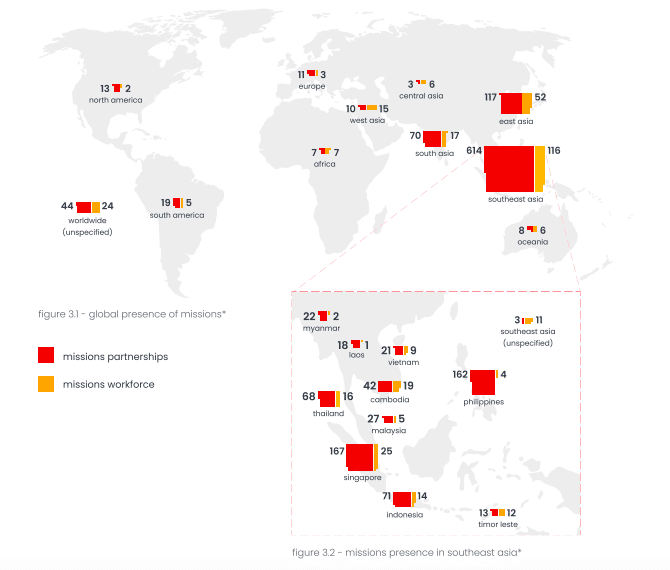
The Singapore missions presence globally, as well as in Southeast Asia. Photo from National Missions Survey 2024.
Aside from Southeast Asia, the study also found a significant missions presence in East Asia (about 15% of total Singapore missions presence) and South Asia (about 7%).
In studying work done among unreached people groups (UPGs), which the study defined as people groups without sufficient indigenous believers to share the Gospel, the study found that slightly more than half (54%) of churches were involved in reaching out to UPGs, an increase from 1 in 3 in 2019.
Reflections from missions leaders:
The Singapore Church’s involvement in Southeast Asia and East Asia is unsurprising as these regions are geographically, culturally and linguistically closer to home, said missions leaders who participated in the focus group discussions.
“Missions workers in Central and West Asia attest to the immense need for Singaporeans in these highly unreached regions.”
“However, missions workers in Central and West Asia attest to the immense need and vast opportunities for Singaporeans in these highly unreached regions,” they said.
Secondly, while the proportion of churches involved with UPGs is an improvement from five years ago and seems encouraging, churches should take note of areas within a country without a viable Christian presence, they added.
Giving an example, they noted that the majority of Singapore missions work in Thailand happens in Bangkok, Chiang Mai and Chiang Rai – regions where more than 5% of the population are Christians. Meanwhile, less attention is given to many other provinces with a Christian population of 0.1%.
Finally, missions leaders said there is a need to adopt more socially and culturally sensitive missions approaches in countries like Thailand and Japan, where Christianity is still largely seen as a foreign religion.
#2: There is a smaller proportion of missions workers among church members today compared to 2019
In 2024, one missions worker was sent for every 109 church members. This is a decrease from 2019 (1 for every 53 members) and 2014 (1 for every 99 members).
These statistics exclude that of megachurches, which researchers omitted due to their sheer size, difficulty in tracking members and unique practice of missions.
In breaking down the statistics by church size, the study found that the most “efficient” sending churches tended to be smaller:
- Churches with fewer than 200 members: 1 worker per 37 members
- Churches with between 200 and 499 members: 1 worker per 91 members
- Churches with 500 to 999 members: 1 worker per 154 members
- Churches with 1,000 to 1,999 members: 1 worker per 107 members
- Churches with 2,000 members and above: 1 worker per 212 members
All categories saw a decline in the rate of sending workers compared to 2019, except for churches with under 200 members (comparable to 2019) and churches with 2,000 members and above (increase from 1 worker per 241 members in 2019).
Reflections from missions leaders:
The decline in sending rates may have been partially due to the COVID-19 pandemic, which forced many field workers to return to Singapore. Additionally, churches may not have fully ramped up missions engagement post-pandemic to raise up new workers, said missions leaders.
Thus, more must be done to raise up a new generation of missions workers, they stressed.
#3: More missions workers under 50 are professionals
In analysing data provided by the 236 missions workers who participated in the Missions Workforce Survey, the study found that:
- 43% are involved in traditional missions work, such as church-planting work, church-based ministries, or work in non-governmental organisations
- 28% are involved in non-traditional missions work, such as tent-making, bi-vocational work, business-as-missions entrepreneurship, or non-residential missions work
- 29% are missions agency staff in denominational missions agencies, international or local missions agencies
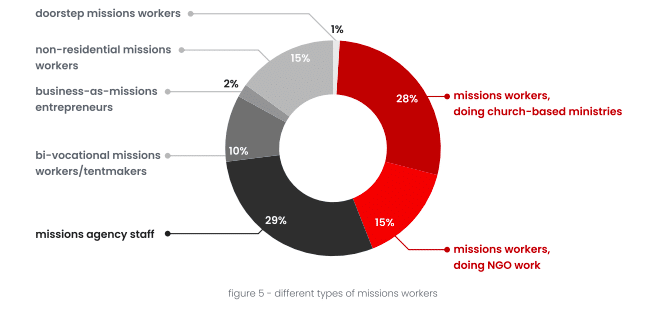
Missions workers on the field are involved in a variety of ways. Photo from the National Missions Survey 2024.
Researchers found that a sizeable proportion of workers are involved in missions through their vocational and professional expertise. This is especially true for the younger generation of missions workers. For example, more than 70% of bi-vocational missions workers and tentmakers are below the age of 50.
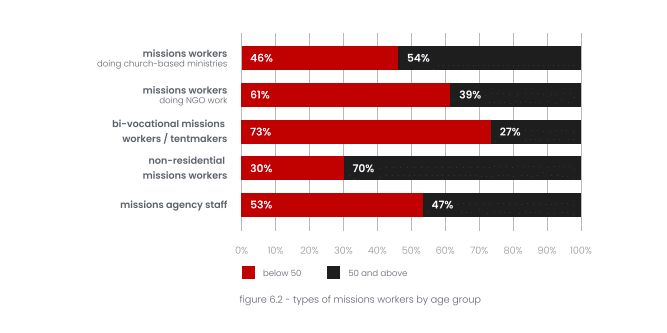
The type of missions workers by age group. Workers aged 50 and above are most likely to be involved in non-residential missions work, while workers below the age of 50 are most likely to be bi-vocational missions workers or tentmakers. Photo from the National Missions Survey 2024.
Apart from missions agency staff, about 1 in 3 of all Singapore missions workers are also involved in a mix of church-based and non-church-based work.
Reflections from missions leaders:
A good number of Singapore missions workers see missions “holistically and integrally”, they noted.
“In the decades ahead, churches’ missions policies could allow for multi-prong engagement with an increasingly diverse world.”
#4: As missions work diversifies, churches are innovating their missions financial policy
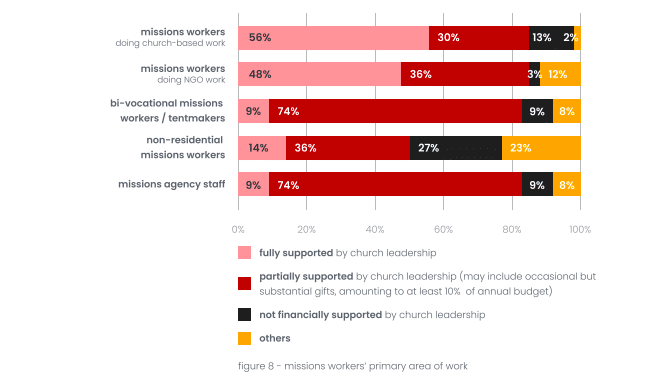
Bi-vocational missions workers or tentmakers and missions agency staff were the least likely to be fully supported by their churches. Photo from the National Missions Survey 2024.
From the focus group discussions, the study found that some churches have developed a “dynamic and multi-tiered financial missions policy” that can serve as a model for others.
For example, researchers cited one way a church financially supported a missions worker involved in business-as-missions: The church provided funds for the worker during the early stages of establishing the business, and eventually removed support when the business became profitable.
Reflections from missions leaders:
Despite the changing face of missions, they acknowledged that maintaining financial support can be an ongoing challenge for all kinds of missions workers.
Thus, regular reviews should be done to ensure a church is adequately supporting its missionaries well.
#5: Only 4% of missions partnerships are related to Bible translation
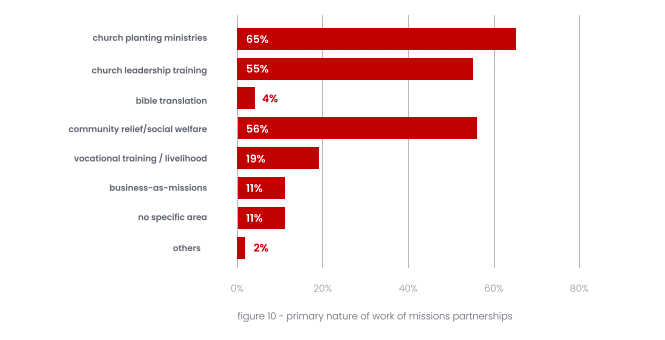
Of the missions partnerships that the Singapore Church is involved in, only 4% are with Bible translation.
The top three things that Singapore churches partner Christians on the mission field to do are: Church planting (65%), community relief and social welfare (56%) and church training (55%).
Meanwhile, only 4% are involved with Bible translation.
#6: Non-traditional missions workers seek more flexible and diversified missions training
Based on the focus group discussions, participants suggested that:
- Local seminaries and missions-training centres diversify their curriculum and allow more flexibility, such as on-field modules for non-traditional missions workers.
- Missions candidates be sent for formal training in a school outside of Singapore, where the socio-cultural context is more similar to their mission field.
- Bi-vocational workers or tentmakers consider relevant internships in Singapore and/or on the mission field, to develop business acuity and acumen.
- Experienced mission workers provide mentorship to the younger generation of missions workers.
#7: Short-term mission trips can be more intentional
When asked about the desired outcomes of short-term mission trips, the top three reasons churches cited were:
- To support the ministry of their missions partners (69%)
- To give their members an experience of missions (54%)
- To nurture long-term relationships in the other country (32%)
The top three main activities conducted during short-term mission trips were:
- Church events (69%)
- Community outreach and improvement (50%)
- Training ministry leaders (49%)
Reflections from missions leaders:
Short-term mission trips risk becoming an end in themselves, seeing that the most common activities are church events and community outreach, they noted.
“Short-term mission trip teams have to be careful not to be too focussed on their programmes and goals on the trips, and instead be intentional in building relationships and understanding the local community,” they said.
To cultivate a missional mindset in their members, churches must preach about missions at the pulpit regularly.
They pointed to some churches that conduct more in-depth pre-trip preparation and post-trip follow-up, including biblical and cross-cultural training, pre-trip engagement with leaders on the mission field, and concerted follow-up efforts.
In addition, they encouraged churches to intentionally build missions communities, for example by continually praying for and engaging with those on the field, as well as organising annual gatherings that help mission trippers share and connect.
Finally, the group urged churches to take the focus of short-term mission trips off the Singapore team and instead consider how to empower communities in the mission field.
#8: More than 80% of churches preach about missions, but only 6% of churches have an altar call for missions
Churches with a vibrant missions ministry integrate missions into church life, instead of seeing missions as a separate ministry for some, noted researchers.
When assessing the frequency of missions activities conducted in local churches, the study found, among other things, that:
- 85% of churches preach about missions during Missions Sunday or Missions Month, but only 20% of churches do it throughout the year.
- 83% of churches engage in regular short-term mission trips, but only 24% of churches teach members to befriend those of different cultures and religions.
- Only 6% of churches have an altar call for missions at least once a year.
Reflections from missions leaders:
To cultivate a missional mindset in their members, churches must preach about missions at the pulpit regularly, teach children and youth about missions (which 55% of churches already do) and encourage members to engage with people of other cultures and religions in Singapore.
They added that “strategically planned short-term missions trips and well-informed prayer guides encourage consistent whole-church involvement in missions”.
#9: About 1 in 5 of churches do not train their missions leaders
Close to 70% of churches send their missions leaders and committee members to missions-related conferences and seminars like GoForth and Antioch 21, while nearly half send their missions leaders for church-run missions programmes.
About 20% send their missions leaders for more formal training, including a missions-related degree at a theological college and training courses by a missions school or agency,
However, 22% of churches do not have any training programmes for their missions leaders.
#10: Close to 60% of churches are involved in doorstep missions
Of the 98 churches that participated in the survey, 56 were involved in doorstep missions reaching out to migrant workers, domestic workers, healthcare workers, international students and their mothers, and expatriates of various nationalities.
A quarter of these churches started their ministries during the COVID-19 pandemic, while about half of them have been engaged in their ministries for over 10 years.

A breakdown of the percentage of Singapore churches doing doorstep missions with various nationalities.
The study noted that these ministries vary: Some churches have set up separate language-based fellowships and church services, while others have integrated the foreigners into their services. Still others only engage the foreigners through outreach activities.
Reflections from missions leaders:
Singapore churches should use “contextualised worship and culturally relevant discipleship” so that these foreigners can integrate more seamlessly back into their communities when they return home, as well as know how to share their faith in socially appropriate ways, said missions leaders.
Read the full National Missions Survey 2024 report here.
RELATED STORIES:
New online tool to help churches engage in missions more effectively launched at Antioch Summit 2024
Land of the Rising Son: Singapore churches are catching the vision of God’s kairos time Japan
We are an independent, non-profit organisation that relies on the generosity of our readers, such as yourself, to continue serving the kingdom. Every dollar donated goes directly back into our editorial coverage.
Would you consider partnering with us in our kingdom work by supporting us financially, either as a one-off donation, or a recurring pledge?
Support Salt&Light


